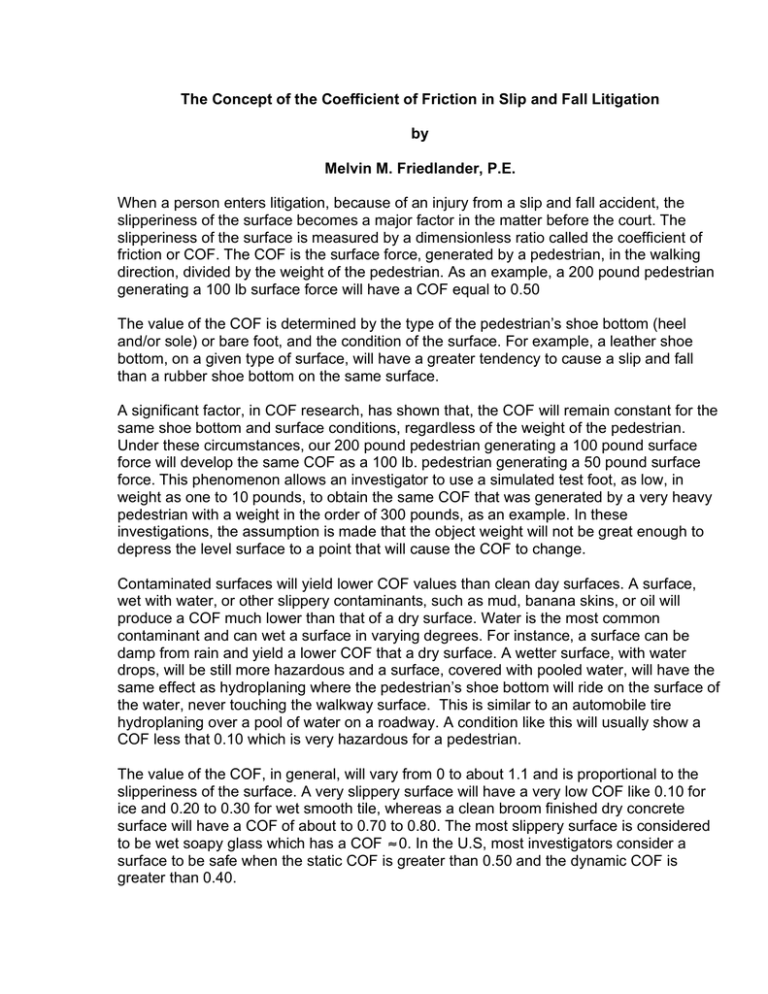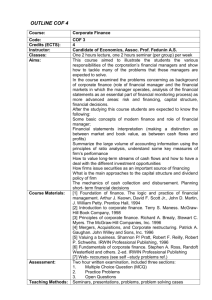The Concept of the Coefficient of Friction in Slip and Fall Litigation
advertisement

The Concept of the Coefficient of Friction in Slip and Fall Litigation by Melvin M. Friedlander, P.E. When a person enters litigation, because of an injury from a slip and fall accident, the slipperiness of the surface becomes a major factor in the matter before the court. The slipperiness of the surface is measured by a dimensionless ratio called the coefficient of friction or COF. The COF is the surface force, generated by a pedestrian, in the walking direction, divided by the weight of the pedestrian. As an example, a 200 pound pedestrian generating a 100 lb surface force will have a COF equal to 0.50 The value of the COF is determined by the type of the pedestrian’s shoe bottom (heel and/or sole) or bare foot, and the condition of the surface. For example, a leather shoe bottom, on a given type of surface, will have a greater tendency to cause a slip and fall than a rubber shoe bottom on the same surface. A significant factor, in COF research, has shown that, the COF will remain constant for the same shoe bottom and surface conditions, regardless of the weight of the pedestrian. Under these circumstances, our 200 pound pedestrian generating a 100 pound surface force will develop the same COF as a 100 lb. pedestrian generating a 50 pound surface force. This phenomenon allows an investigator to use a simulated test foot, as low, in weight as one to 10 pounds, to obtain the same COF that was generated by a very heavy pedestrian with a weight in the order of 300 pounds, as an example. In these investigations, the assumption is made that the object weight will not be great enough to depress the level surface to a point that will cause the COF to change. Contaminated surfaces will yield lower COF values than clean day surfaces. A surface, wet with water, or other slippery contaminants, such as mud, banana skins, or oil will produce a COF much lower than that of a dry surface. Water is the most common contaminant and can wet a surface in varying degrees. For instance, a surface can be damp from rain and yield a lower COF that a dry surface. A wetter surface, with water drops, will be still more hazardous and a surface, covered with pooled water, will have the same effect as hydroplaning where the pedestrian’s shoe bottom will ride on the surface of the water, never touching the walkway surface. This is similar to an automobile tire hydroplaning over a pool of water on a roadway. A condition like this will usually show a COF less that 0.10 which is very hazardous for a pedestrian. The value of the COF, in general, will vary from 0 to about 1.1 and is proportional to the slipperiness of the surface. A very slippery surface will have a very low COF like 0.10 for ice and 0.20 to 0.30 for wet smooth tile, whereas a clean broom finished dry concrete surface will have a COF of about to 0.70 to 0.80. The most slippery surface is considered to be wet soapy glass which has a COF ! 0. In the U.S, most investigators consider a surface to be safe when the static COF is greater than 0.50 and the dynamic COF is greater than 0.40. The probability of a slip and fall increases with the decrease in the COF. With a COF approaching 0, the probability would be close to 100%, whereas with a COF = 0.5 or above, the probability would be very low. As a matter of fact, a surface could get so high in the COF value, or traction, that it could lead to a trip and fall due to stumbling. There are two types of COF conditions. The first is called the static COF and the second is called the dynamic COF. In the classical sense, the COF is measured by placing a flat block (usually metal) on a clean level surface and then initiating a pulling force, on the block, where the force is parallel to the surface. The static COF is determined by the value of the force, at initiation of motion of the block. It is calculated by dividing the measured force by the weight of the block. The dynamic COF is determined by same method, but the force is measured while the block is moving. The dynamic force is usually smaller than the static force. The COF is measured by devices called slip-testers or tribometers, which can vary in complexity from the simple block, pulled over a surface (and sophisticated variations of this type), to articulated or pendulum instruments with many parts that can be actuated by some sort of trigger mechanism. In addition. a ramp-type device, using humans and a self propelled dynamic tester, is popular in Europe Research also shows the development of robot slip-testers. With the exception of the ramp, all of the instruments, basically measure static or dynamic COF in the same manner as accomplished with the simple block.. All slip testers attempt to simulate the motion of the bottom of the shoe or bare foot, and hence the COF, either at the initiation of a slip or after slip is initiated. This is accomplished by using material (called a sensor), placed at the bottom of the tester. Popular materials for a sensor are Neolite, leather, rubber and a material called silastic (Silastic is used for testing bathtub and shower slipperiness).In addition, the Brungraber set of tribometers can use any sensor desired such as the bottom of the shoe that was worn at the time of the accident. Depending on accident conditions, testing is normally done, at the site, on dry, contaminated, and/or wet surfaces.


